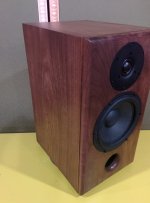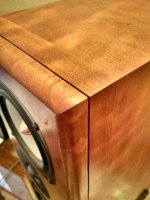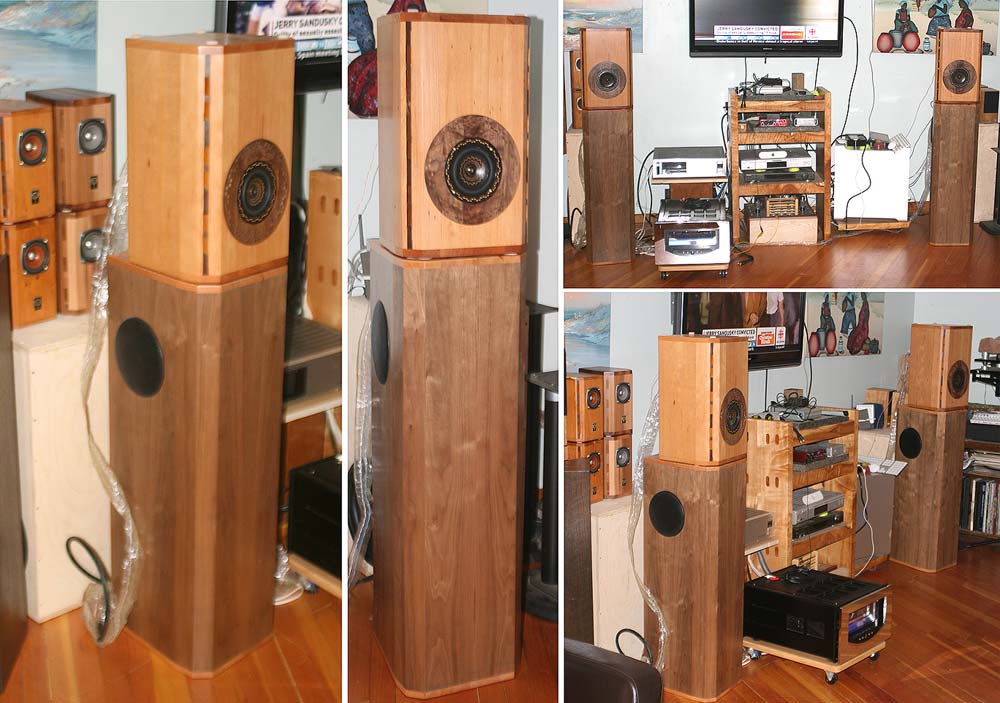Oversize and then trim is best.
Also,over time, the hardwood can expand or contract and create a step, depends on the hardwood and humidity. On the this speaker that I made, I over sized and then trimmed flush with a flushing V-groove bit, then I rounded over the edges. I like a visual separation between baffle and panel. Next time I will cut(practice first) a v-groove right where the veneer meets the hardwood, most of the V cutting into hardwood as not to cut through veneer and into the substrate - This will remove any possible glue-line, allow hardwood to expand a little and not be obvious, and add visual interest. Many other profiling ideas are possible for this type of edge design.
Also,over time, the hardwood can expand or contract and create a step, depends on the hardwood and humidity. On the this speaker that I made, I over sized and then trimmed flush with a flushing V-groove bit, then I rounded over the edges. I like a visual separation between baffle and panel. Next time I will cut(practice first) a v-groove right where the veneer meets the hardwood, most of the V cutting into hardwood as not to cut through veneer and into the substrate - This will remove any possible glue-line, allow hardwood to expand a little and not be obvious, and add visual interest. Many other profiling ideas are possible for this type of edge design.
Attachments
No reason to get scared. It takes less time to redo veneer than paint. And a protective finish can be as easy as a wipe-on.(or as complex as you like)
If your time is worth anything it's a wash or cheaper than paint without a fancy shop(and all those hours to get both good and fast).
(I still like a deep candy apple finish, though I need to be paid to do it.)
If your time is worth anything it's a wash or cheaper than paint without a fancy shop(and all those hours to get both good and fast).
(I still like a deep candy apple finish, though I need to be paid to do it.)
The hardwood rounded profiles, at least those i can get here, would be of hardwood or some pine. I think they`d open up gaps after some time due to difference in thermal expansion. You can veneer all over - I`ve done down to 1/2" radius and that at 90 degrees to the strain - it is possible but needs paper tape on the outside to prevent the veneer from craking, then it bends. Out of 7 such loudspeakers, one cracked once and once it had an airgap so had to be removed and reveneered, but considering the small radius, I would call it a success. If you use a larger roundover bit on a table, it could be much easier. I`ve not done 1" or similar but think they should be much easier.
Looks good, Daniel!
That's what I was aiming for but I got to scared.
I have no intentions of redoing this effort -- solid wood in the corners is so much better. 🙂
But thanks! The boxes definitely look great in person. There are bubbles under the embedded magnets (for theoretical grills), sadly, but c'est la vie.
Really impressed with the designs put up in this thread. Thanks everyone. Highly skilled forum members
I have no intentions of redoing this effort -- solid wood in the corners is so much better. 🙂
But thanks! The boxes definitely look great in person. There are bubbles under the embedded magnets (for theoretical grills), sadly, but c'est la vie.
I think I missed something, that your fronts are veneered?
My front panel is solid walnut. I plan to make a few in this manner with various hardwood species.
Also, for Painting, I'll solid poplar fronts.
Oh! Yes, Joel, these are all veneer. And doing the veneer around these corners was a giant PITA. 🙂
Thank you gentlemen. No dry runs, just pure masochism with a razor blade, and one corner out of all of them that's less good.
To be fair, we used a thin layer of urethane sheet and a clothes iron to adhere the veneer to the shellac'd MDF, so there was plenty of time to dry fit the curves before setting.
As I said, not recommended. 🙂 May lead to other forms of masochism with a razor blade. (I kid!)
To be fair, we used a thin layer of urethane sheet and a clothes iron to adhere the veneer to the shellac'd MDF, so there was plenty of time to dry fit the curves before setting.
As I said, not recommended. 🙂 May lead to other forms of masochism with a razor blade. (I kid!)
Last edited:
If you dont have the means to resaw your own veneer some wood dealers are offering bookmatched sliced veneer at 1/16" thick. Much easier for sanding planing etc.
All. I'm not sure about elsewhere, but in UK hardwood (oak, walnut and maple etc) seems to be pretty damn expensive. For edging, would you get a similar result using softwood? Or would the quality be lacking visually? Or are there any practical limitations etc. I'm guessing hardwood is easier to shape well due to its higher density.
It's not cheap here, although I just craigslisted a screaming deal on a lot of English walnut (variety, not shipped here!).
If you want to go for walnut veneer, go all out -- half measures will look terrible, IMO, and the softwood edges would stick out like a sore thumb.
Honest question: if this is for a subwoofer, then any roundover is purely visual, not for performance reasons. If we forego the roundover then it would only ask that you be able to lay up veneer on flat surfaces, which isn't really problematic to lay up. Otherwise, it's really about getting the real-deal walnut.
If you want to go for walnut veneer, go all out -- half measures will look terrible, IMO, and the softwood edges would stick out like a sore thumb.
Honest question: if this is for a subwoofer, then any roundover is purely visual, not for performance reasons. If we forego the roundover then it would only ask that you be able to lay up veneer on flat surfaces, which isn't really problematic to lay up. Otherwise, it's really about getting the real-deal walnut.
A lot of woods go well together, i frequently use more than one species in a given project. Mixing pine with walnut would not be a good choice but maple is good if you like the contrast, white oak gives a more suttle mix.
Last edited:
Completly covering the solid edging in veneer then re_exposing it by chamfering or planing in a bevel can also work.
You can use what ever accent wood you like. My opinion was based on the aged yellow look of eastern white pine.
- Status
- Not open for further replies.
- Home
- Design & Build
- Construction Tips
- Rounding veneered mdf, possibly?



